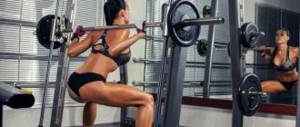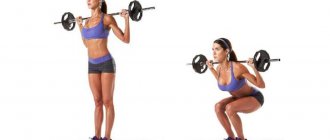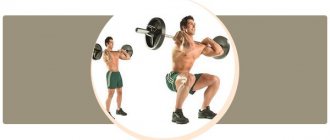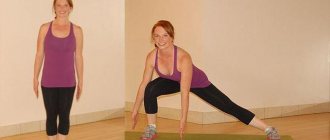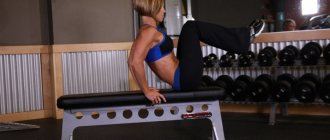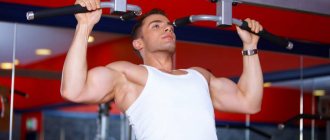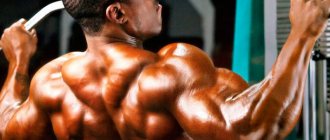Recently they have begun to say that barbell squats are not necessary. Indeed, it is easier to tell a beginner that his destiny is extension and flexion in the machine, and some kind of leg press, than to explain the technical nuances of this basic exercise, systematically work on strength and flexibility, set technique, monitor the body, the work of the knees, shins, hips, do not allow the pelvis to “peck”. In fact, the squat is available to everyone who has no contraindications to bending the knee, ankle and hip joints, and no contraindications to axial load on the spine. The movement is performed in all sports, and in fitness there is a place for a good technically correct squat, and not just half squats with a body bar.
Benefits of Exercise
For a fitness specialist, the main advantage is the opportunity to work out maximum muscles in a minimum of time. The truth is harsh - a person who does, for example, 4 working sets of squats of 8-10 repetitions with a relatively high weight, pumps up his abs and goes home or to work will be better built than his friend who hangs out in the gym for an hour and a half, but only does flexion and extension, and, at most, some platform leg presses.
For athletes and advanced amateurs, the squat is good because:
- Builds overall lean body mass . The back also grows from squatting, it’s not for nothing that experienced people will always identify someone who is lying about their working weights on the Internet precisely by the appearance of their “pillars” (long back muscles);
- Allows you to work more powerfully with your legs in all sports disciplines . MMA fighters and boxers, track and field athletes and football players squat with a barbell. Yes, they don’t lift the same weights as powerlifters, but they do this exercise to build power in the off-season. Plus, power squats are a key way to prevent injuries;
- Changes the shape of the hips and buttocks . In "old school" bodybuilding there is no leg training for a healthy person without squats. Lunges and platform presses are auxiliary exercises, squats are the main ones;
- Serves as an indicator of overall strength . Although pure strength is mostly tested, it is only useful to know it in powerlifting competitions. And exercises like the leg press are not indicators of strength, since they do not work the core muscles;
- Improves health , including blood circulation in the pelvic organs, and increases bone strength;
- Increases energy expenditure during training, helps burn fat and build muscle
Opinions differ regarding the benefits of squats for beginners and exercise enthusiasts. Objectively, squatting with minimal weights improves coordination of movements, increases joint mobility and strengthens ligaments. It does not contribute to injury if performed smoothly and under control. Opponents of beginner squats argue that such people's muscles are too weak to support the weight on their back and perform the movement technically correctly. In fact, it makes sense to give a short period of “pumping up” the muscles in the machines before squats, but it’s not worth delaying it for 4-5 months, as some trainers do, so as not to teach beginners the technique. The problem with beginners and amateurs is precisely the lack of skill and low joint mobility. The easiest way to do this is by squatting.
Changes in squat loads during preparation
Almost all athletes understand that it is not possible to achieve constant progress by simply linearly increasing working weight. This applies not only to a specific exercise, but also to the overall result in all three competitive movements. Thus, the best option is to divide the entire process of training an athlete into phases:
- General preparatory;
- Preparatory;
- Pre-competition;
- Competitive.
Based on the specific training period, you can plan the load in each exercise.
Let’s say, during the general preparatory phase, the load should be large in volume, which corresponds to 4 to 5 sets of 8–10 repetitions each. The working weight should be from 60 to 70 percent of the one-repetition maximum (1 RM). During this period, you can work on improving your technique using additional funds. During the preparatory phase, the volume should be reduced. This corresponds to the same 4–5 sets, but the number of repetitions will be reduced to 6–8. The working weight will also increase, which at this stage of preparation will already be from 70 to 80 percent of 1 RM.
During the remaining two periods, the volume should be reduced even further, which could mean 4 to 5 sets of 1 to 5 reps each. The weight of the projectile, in turn, increases even more - up to 80–95 percent of 1 PM.
The scheme described above allows the athlete to work fruitfully both on the technical side of the exercise and to increase muscle strength.
Execution technique
Beginners begin to learn the exercise from a squat to a box below the parallel of the femur with the floor. They perform the movement without a barbell, with a weight held at the chest, or with a body bar on the shoulders. As soon as a person acquires the skill of squatting with a straight back, without “unwinding” the lumbar region at the bottom of the exercise, and without bending too much forward, he can begin to be taught a classic squat with a barbell.
Before approaching even the minimum weight, you need to tune in and “scroll” the sequence of actions in your head. There is no need to run under the bar as quickly as possible and remove it at random, even if there is a line in the gym for the apparatus. Concentration in squats is the key to avoiding injury.
It's BAR SQUATS, baby!
Performing squats
- The bar is installed at the height of the athlete's collarbones, or slightly lower. You need to come up, stand under the barbell in one movement and place it on the lower part of the trapezius muscle. In fitness, it is better to avoid squats with the bar positioned on the top of the trapezius. They are quite traumatic for the cervical spine, and a novice athlete cannot always carefully remove and place the barbell from the racks, which is why he injures his neck;
- The grip should be slightly wider than shoulder-width, but stable, so that your hands do not slip towards the plates. Wider grips are allowed if shoulder mobility is lacking, but loss of balance must be avoided. The back should be tense and arched, that is, the shoulder blades are brought to the spine and lowered, but the abs are tightened and compensate for the natural lordosis. You should not throw your tailbone up; if such a movement occurs naturally, you need to tense the front surfaces of your thighs and “tilt” your pelvis forward so that the pelvic bones begin to point straight forward;
- The neck is level. The feet are on the same line under the bar, the bar is projected onto the middle of the arch of the foot, the knees are slightly bent. In one motion, the athlete extends both knees and lifts the barbell above the racks;
- Then you need to pull your stomach inward to stabilize, make sure the bar is lying flat, and take three steps - right foot back, left foot to right, and feet shoulder-width apart or slightly wider. Socks are turned to the sides, not forward. Do not squat with a barbell with parallel feet. If you need this particular version of the squat, it is better to fix your shin in a special machine and hold the weight in front of you;
- Next, the athlete makes sure that his back is slightly tilted forward, his shoulder blades are pulled together and lowered, his abs are tightened, he inhales, and begins to spread and bend his knees towards his toes. There is no need to make any movements of the pelvis. And even more so, you should not reach back, sit on an imaginary chair, etc. The energy from bending the knees and shins is enough for the hip joints to work in the plane intended for them by nature, and not the plane imagined by novice bodybuilders. On the contrary, during a squat you need to monitor the “rotation” of the pelvis and the tilt of the back. The first must be absent, and the second must be minimally acceptable. Only tall people with a long thigh squat in a “fold”, that is, initially with a tilted back, they have no other anatomical option;
- You need to squat not until the thigh is parallel to the floor, but until the pelvic bones go below the top of the kneecap. Contrary to popular belief about “the safety of the parallel squat for the knee,” the peak load in the parallel technique falls on the anterior cruciate ligaments. If you sit a little lower, the load will be evenly distributed between the hip, ankle and knee joints, and the ligaments will not be damaged;
- As soon as the touch is achieved, you need to push off powerfully with your legs and begin to straighten your knees and rise. Back movements in fitness should not be performed on small and medium weights. Similarly, you should avoid shifting your center of gravity to your toes;
- There is no need to squat quickly. You should return your back to its original position and control your abs before each repetition;
- When all the repetitions are completed, you need to go to the racks and, by bending both knees, return the barbell to them.
Efficiency Tips
- There is no need to remove and lower the barbell “in scissors,” that is, in a lunge position. With the working weight, the athlete can swing forward or to the side, and he will fall;
- A low bar squat is allowed, but not the “bar over the shoulder blades” position. This is sometimes given to girls to “load their buttocks.” Fans of loading the buttocks can do any bending with a barbell or a gluteal bridge after squats, but breaking the shoulder joints for the sake of a ghostly shift in emphasis is not worth it. Moreover, for most people, an extremely low bar means an equally significant tilt of the body forward;
- Advice from illiterate amateurs regarding moving the pelvis back and maintaining a depth below parallel is mutually exclusive. If a person takes something there, he will only reach it by “pecking with the pelvis”, or in a position where the body lies on the hips. Therefore, you need to clearly decide for yourself. If there are no injuries that prevent you from squatting, you should squat deeply, due to the movement of your knees and without moving your pelvis back. If they exist, it is worth discussing with your trainer options for replacing the squat with another multi-joint movement for the lower body;
- Bringing your knees past your toes in a squat is not dangerous, or rather, it is a necessary condition for a squat for people with long thighs. It is dangerous to squat with your kneecaps straight forward with your feet parallel. Socks should be turned out as far as the hip joint allows, all other options are not acceptable;
- But the placement of the feet wider than the anatomical width that the hip joint allows is also dangerous. This can cause injuries to the joint that takes the longest to recover, and even stretching of the adductor muscles as an unpleasant addition;
- The width of a squat “for health” is determined simply. The athlete is forced to make a high jump and land at a comfortable width. The placement of your feet upon landing will determine the possible width of your stance. It is allowed to move your legs 2-3 cm outward or inward, but do not “turn” them to the sides for the sake of a ghostly desire to pump up your buttocks. By the way, a wide squat, in addition to the buttocks, does a good job of growing the adductor muscles of the thigh, so those who like large pelvises and thin legs will not get what they want here
A Simple Way to Increase Your Barbell Squat Results
Want to learn how to not be afraid of heavy weights in squats? Then read the article “A simple way to increase your results in barbell squats”...
Each of you has probably noticed more than once that when you approach your maximum weights in squats with a barbell or simply start working with quite large working weights, then this weight simply begins to psychologically crush you.
You begin to involuntarily shake under the barbell and each time you are afraid of whether this time you will be able to complete your working approach at all or whether the weight that you planned for your workout will simply crush you.
Every time you stand under the barbell, do you spontaneously start thinking whether you can lift it or not?! It is clear that with such an attitude you will begin to be even more afraid of the weight you are working with, hence the psychological panic and shaking with the barbell.
But there is one simple and very effective method of not being afraid of the upcoming weight you are going to work with.
To do this, before starting your working approaches, perform a couple of isometric holds with a barbell for 10-15 seconds.
What is this anyway? In essence, these are simple holds with a barbell that will very quickly strengthen your psyche and your muscles before the working approach.
Place the weight with which you are going to squat on the bar, remove the bar from the racks, step back and just stand with this weight for 10-15 seconds and do 3-5 approaches of such static approaches.
Then rest for 5-10 minutes and proceed to your usual squats.
Example, barbell squats and barbell static holds before work sets:
Warm-up approaches:
- 20 kg x 10 reps
- 60 kg x 5 reps
- 100 kg x 5 reps
- 140 kg x 5 reps
- 180 kg x 5 reps
- 190 kg x 3 reps
Static holds with a working weight in this case is 200 kg, 3-5 sets of 10-15 seconds
- Rest 5-10 minutes
Then the working approaches:
- 200 kg 5 sets x 5 reps
You will be surprised how light your barbell and the working weight with which you will then squat will seem after this.
This simple method will quickly strengthen your stabilizer muscles and prepare you for further work with this weight.
Many athletes I advised to do this were even able to perform significantly more repetitions than they originally planned to do.
At the same time, they stopped shaking under the barbell every time and they were able to perform their squats with the barbell more effectively, and were also able to progress much faster later.
How to choose weight
Some exotic methods of selecting weights are not for squats. This is not a failure exercise, at least not until the person can control his or her body position in any state of fatigue. Repetitions are done from 3 to 12, sometimes more, this is determined by the level of the athlete and the purpose of the training.
Otherwise, follow the rules:
- The last 2 repetitions should be difficult, but for the purposes of health-improving physical education, “work” is not the hellish bending of the back forward, knees drawn inward, and lifting the pelvis upward. This is a tangible resistance of the muscles to the load, that’s all;
- You should always start with an empty bar, then move in steps from 5 to 10 kg, up to the working weight;
- It is possible to perform with different weights on different days, since recovery after training is not linear;
- Once you reach the level of “squatting your own weight” for women, and “squatting 1.5 times your weight” for men, periodization is required, that is, cycling light and heavy workouts, even if you squat once a week
Impact on the lower back and knees
Injured athletes and people with hyperlordosis should be conscious about squat training. Many people should not perform squats, at least until full recovery has been achieved.
The movement itself is not dangerous to the lower back and knees, and with weights no greater than your own can be performed without benders, bandages, or a belt.
To prevent injury, you need to pay attention to:
- Press work . The stomach should not fall forward and be relaxed. The belt push is performed only if the athlete does power squats; it should be avoided in fitness;
- Initial position of the pelvis . There is no need to stretch your buttocks upward, as we often see in photos from fitness magazines. It looks beautiful, but is very traumatic for the lower back;
- The position of the knees . They move in the plane of the foot, towards the toes, rather than inward;
- Ankle mobility . If your shin is “clogged” from walking in heels or trying to pump up your calves, you should roll it with a roller and stretch it a little before you start squatting.
Basic squat technique
Before moving on to performing strength approaches, it is necessary to establish the ideally correct technique; the final result will depend on the technically correct execution of the exercise. A technically incorrect exercise can lead to injury, often due to incorrect positioning of the legs, arms, head or torso.
Projectile position
- Low position : the barbell is located on the upper back (shoulder girdle) in the area between the rear deltoids and the trapezius. This position makes it possible to control the apparatus from the initial phase of the downward movement with the barbell on the shoulders to full extension of the knee joints in the upper phase. This technique makes it possible to tilt the torso forward without fear of injury, the key factor is physical strength, the back muscles and the back of the thigh are most involved in the work, and it gives an advantage in working with large weights.
- High position : the bar of the bar is fixed on the athlete’s trapezius, the position of the torso is more vertical compared to the low position, the main load falls on the quadriceps (quadriceps) and gluteal muscles. The high position is dangerous, the bar is located close to the cervical spine, and if the movement is poorly coordinated, you can get serious injury. Low involvement of the hamstrings.
Smith machine squats
This should be the shortest section. The upright Smith machine is not designed for squats. You can still do bench presses, lunges and vertical presses in it, but not squats. Why? It's simple. During the squat, the barbell moves in a straight line only for super flexible professional level athletes. For most fitness specialists, it “travels” along an elliptical path, and this is normal. If you “forcibly” try to straighten the trajectory, the load on the hip joint increases. If you place your feet slightly incorrectly, you can get injured.
The Smith squat “square”, that is, in the “feet in front” position, is one of the most anatomically unnatural movements that overloads the spine. It is contraindicated for scoliosis, hernias, protrusions and even simple pain in the lumbar region due to hypertonicity. It is performed in bodybuilding to shift the load to the buttocks, but it is done either by healthy people or by those whose priority is pumping up the buttocks rather than maintaining health.
There are benefits of training at Smith, perhaps, for high-level bodybuilding:
- During training, an athlete can use work “almost to failure”, since he has the opportunity to place the barbell on the supports at any point of the amplitude;
- In one approach, you can change the placement of your feet;
- A variety of positions of the bar on the back are allowed, including very high
If a person cannot barbell squat according to his level of fitness, he should do a goblet squat or a cable squat, but not a Smith machine movement.
Squats in a training microcycle
The average length of a squat training microcycle is 7–14 days.
For most athletes, 7 to 10 days are often enough for full recovery. The placement of the competition movement in your training cycle during this time period is very important and will most directly affect your performance.
Most often, squats are best done as the first exercise on a high-load day, which corresponds to the first day of the microcycle. On the day of low load (the fifth in the microcycle), it is better to put squats as the second exercise.
This corresponds to a seven-day microcycle. If you use a different microcycle length, you will need to make the appropriate changes. This way, you can get the most out of your workout and fully recover.
Squats for girls
Many people are afraid of “swinging their hips,” but since this issue is not decided by training, but by nutrition, fears can be left outside the gym. Girls who eat “to lose weight” will not build up an impressive mass.
Here is an example of a squat workout “for weight loss”, all exercises are performed for 12-15 repetitions, with strictly 45 seconds of rest between sets:
- Bar squat;
- Romanian deadlift with dumbbells;
- Hamstring curl;
- Gluteal bridge;
- Hip extension in glute crossover
Squats. Execution technique for girls
How to Break a Barbell Squat Stagnation
Posted by mr_Vlad , 08:16
- Log in to reply to this topic
There are no answers in this thread
#1
Sent - 08:16
How to overcome plateaus in barbell squats?
Classic squats with a barbell are the basis for training leg muscles. This article contains useful tips and tricks for successfully completing the “stagnation” stage of this exercise.
Let’s imagine a situation: an athlete is squatting with a barbell weighing 100 kilograms, but the weight is 102 kg. he fails to master it. How to get out of this situation?
Tip #1.
Change the type of squats. In the classic version, this exercise is performed with a bar located behind the athlete’s shoulder blades. Try reducing the working weight by 25-30% and performing exclusively front squats for two to three weeks. In this case, the bar is placed on the shoulders (in front of the neck). Squat as deep as possible. Maximum amplitude will give the exercise the greatest effectiveness.
Tip #2.
Reduce the range of motion of your legs. This advice contradicts the previous one, but still has a full right to exist. Lower yourself only 10-15 cm. These repetitions will be very easy, so it is recommended to increase the maximum weight by 20-25%. Unlike front squats, this exercise cannot become a basic exercise on leg training day. It can only act as an additional, final one. For example: after successfully performing classic squats, add 15-20 kg. on the barbell and perform the maximum possible number of repetitions with a weak amplitude.
Tip #3.
Let a partner help you do squats with a weight that is too heavy for you. Even a slight impact from your partner will provide the necessary strength to complete the most difficult approach. Don't be afraid to ask for help. Do it with the help of a partner five, seven, ten times! Perform repetitions as much as your strength allows! Ask your partner to ease up on the bar over time, and you'll soon be able to perform squats with previously impossible weights on your own.
Tip #4.
Forget about squats for a month. The modern gym provides many opportunities to exercise your legs without doing the basic classics. For example, focus on the bench leg press. There will not be step-by-step instructions on how to develop leg strength with this exercise. Just decide on the starting weight and go into battle!
Tip #5.
Emphasis on assistance exercises. When performing classic squats with a barbell, not all leg muscles are used. Try shifting the priority from basic exercise to auxiliary exercises for 2-3 weeks. For example, increase the number of repetitions of seated leg extensions, standing (or seated) barbell calf raises, and dumbbell lunges (returning to the starting position or moving).
Tip #6.
Forget about training your legs altogether! Not forever, of course. Let it be a “vacation” for 3-4 workouts. Let your muscles recover. Take a break for such a period that you are absolutely sure that your muscles are one hundred percent ready for new loads. Don't be afraid to lose your strength. Either way, you can be back to normal in no time. Moreover, it is quite possible that this kind of break will benefit you and allow you to raise your “maximum” bar.
The tips presented in this article must be followed individually and one at a time. If the first tip did not give the desired result, return to regular training and after a month practice tip No. 2.
By performing such extraordinary workouts, the athlete will “surprise” his muscles and the body as a whole. As a result, this will give previously unknown strength that will allow you to overcome absolutely any “stagnation” in squats with a barbell.
Finally, a useful tip: after each workout, work on stretching your leg muscles. As practice shows, having good flexibility increases strength in squats by approximately 10%!
Good luck!
Back to Powerlifter Training
Number of users reading this topic: 1
0 users, 1 guests, 0 anonymous
Reply to quoted messages Clear Source: forum.asteroidov.net
Types of squats
These variations are performed to work the muscles more deeply, or to work on the weak points of the power movement in powerlifting.
"Sumo"
Simulates a stance in a sumo deadlift. Develops hips, buttocks and hip adductors.
Frontal
The barbell is held on the chest, a clear approach is required. The body cannot tilt forward.
Zerchera
The barbell is held by bending the elbow, at waist level. The movement serves to correct excessive forward lean in the classic barbell squat.
Hackenschmidt
The barbell is grasped with a straight grip behind the back. Some believe that this works the hamstrings and buttocks better.
Lunge Squat
One of the scissoring movements that corrects leg imbalances is essentially one foot placed slightly back on the toes and the athlete simply lowers into a squat from that position.
One leg squat
The athlete stands on the box, stretches forward or simply lowers the non-supporting leg and performs the movement first with one leg, then with the other. This is necessary to correct the “difference in strength” of the legs.
Front Squat
Separately, we can highlight the front squat, a type of basic classic squat. This exercise is practically no different from squats with a barbell on the back; the basic principles and approaches are the same: the position of the legs, the position of the lower back and head.
The barbell is placed on the chest, the position of the arms may vary, classic weightlifting with the elbows bent up or crossed in front of you. Allows you not to load the lumbar region, well suited for beginner athletes, giving you the opportunity to improve your technique without fear of injury.
The technical complexity of this exercise does not allow working with heavy weights (exception in the photo :)).
So, the barbell squat is a classic basic exercise that allows you to achieve good results in the gym, depending on your goals and objectives. Together with a proper balanced diet, it will allow you to build muscle mass or burn excess fat.
